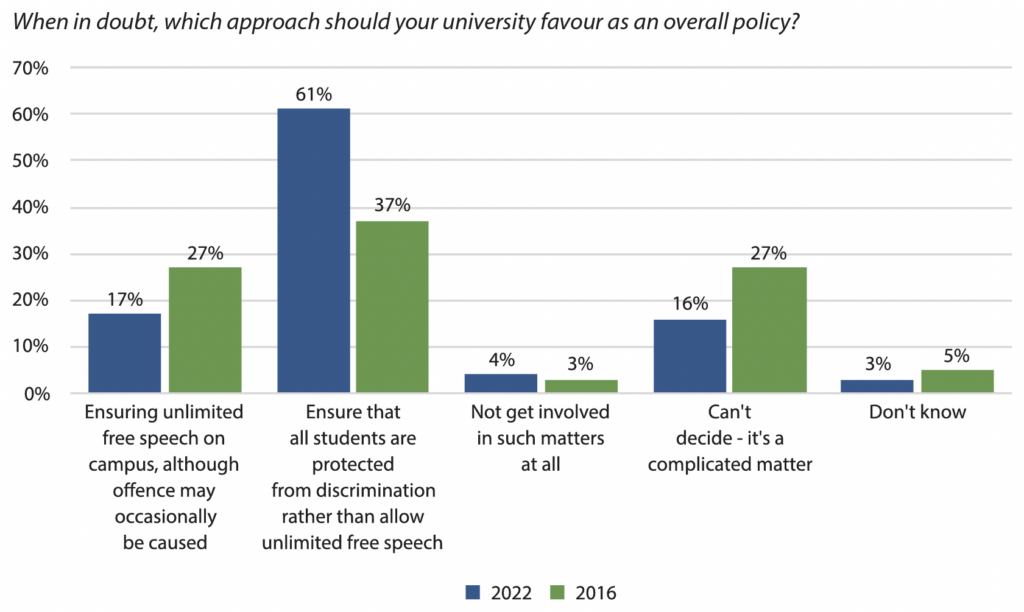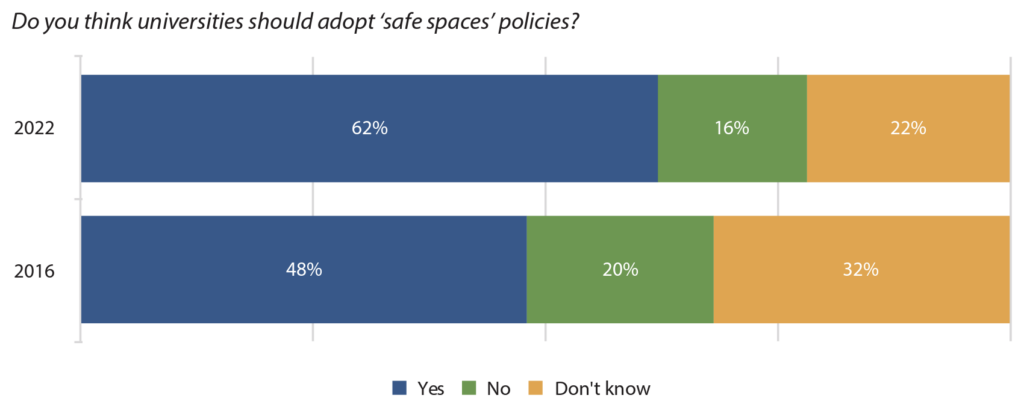The Higher Education Policy Institute has just published a survey of British students’ attitudes to free speech. It’s basically a repeat of the survey they published back in 2016, which allows us to look at trends over time. Unfortunately, as Toby has already noted, they’re not pretty: students have become less supportive of free speech over the last six years.
One example is shown in the chart below. Respondents were asked which of two overall policies their university should favour.

Back in 2016, 27% said “Ensuring unlimited free speech” versus 37% who said “Ensure that all students are protected” – a 10-point gap. Yet by 2020, the percentages were 17% and 61% – a 44-point gap!
What’s more, students are in collective denial about the diminishing status of free speech on campus. In this year’s survey, only 38% agreed that “universities are becoming less tolerant of a wide range of viewpoints”. The rest were either unsure or said they disagreed. Unsurprisingly, women were substantially less likely to agree.
Interestingly, if we compare attitudes in Britain to those in America, there’s less evidence that things are getting worse. Since 2016, the Knight Foundation has carried out four surveys of American students’ attitudes to free speech, asking the same kinds of questions as the Higher Education Policy Institute.
The chart below shows results for a question in the Knight Foundation’s survey that’s almost identical to the one above.

The first thing to notice is that the majority of respondents said “Allowing students to be exposed to all types of speech” is more important than “Protecting students”. This doesn’t mean American students are more pro-free speech than British ones: once you get into specifics, levels of support for censorship are similar.
What’s also worth noticing is there hasn’t been a rise in the fraction of respondents saying “Protecting students” is more important than “Allowing students to be exposed to all types of speech”. (Although note that 17 percentage points of those who held the opposite view moved into the “No opinion” category.)
Another question that both surveys asked was about ‘safe spaces’. As shown below, the British survey found a noticeable increase in support for those policies – from 48% in 2016 to 62% in 2022.

However, the American survey found a noticeable decrease in support – from 87% in 2017 to ‘only’ 60% in 2021. This is shown in the image below. (The other two charts in the image show there’s no obvious trend in support for speech codes or speaker disinvitations either.)

Why the different trends in the two countries? One possibility is that American campuses reached a peak of opposition to free speech earlier than British ones, and the latter are now playing catch up. Which would make sense, given that American campuses are probably the global epicentre of woke ideology.
In any case, neither the British nor American surveys make for encouraging reading. A large fraction of students simply don’t endorse the kind of values that make truth-seeking possible. And that’s not going to change overnight.
Stop Press: Professor Doug Stokes told Darren Grimes on GB News why falling support for free speech among British students is something we should be concerned about.

 GB News on YouTube
GB News on YouTube 











To join in with the discussion please make a donation to The Daily Sceptic.
Profanity and abuse will be removed and may lead to a permanent ban.
Too late for a “probe”. The BBC has to be privatised and broken up at the same time, to minimise as far as possible any inbuilt advantage. It’s beyond saving.
I used to think this. But I now believe it must be actively disbanded.
The BBC is simply too dangerous to be left to its own devices. We pay for it so we get to decide.
I still think it. Without the false halo of being the supposedly disinterested state broadcaster, the BBC is just another media globocorp. There are plenty more out there just as woke and just as committed to the globalist nonsense.
Might as well get some money back for it. And you never know, the kind of government that would actually do that (rather than make occasional demonstrative feints towards it to keep their voter fodder fooled, like the “Conservatives”) might be the kind that would cut taxes or borrowing as well.
No get rid of it. It will still call itself the BBC and retain some totally undeserved mystical quality for the masses of brain-dead who stalk the land.
The BBC has done just what it was required of it by the Government – it has censored and misrepresented the whole Covid Scam and cancelled those who spoke the truth while running the Globalist narrative without comment so why would they want to change it – that would be so ungrateful?
More likely Knigthoods and Damehoods for the entire News operation!
‘Sir ‘Edwards… arise!
Surely, those who are participating in this ”bias” should be held to account, as they’re using public money to disseminate their own prejudices. It’s known who they are. Yet they’d be ”let go” with sackloads of OUR money.
Yes, not even copper handshake for the “journalistic” staff and newsroom controllers.
Yes get rid of it and then turn our sights towards Channel 4.
If they meant more than making soundbites the first thing they’d do is decriminalise nonpayment. Just more hot air to appease the masses.
Had my third red notice in 12 months yesterday that they’re going to come and do an inspection…. Bring it on!
Third? I’m getting threatograms every month now. For something I don’t use, purely because they act on the assumption that if there is a house there must be people watching TV in it.
I get the threats too it seems they ‘open up’ a new case against me every other month.
it seems they ‘open up’ a new case against me every other month.
Have kept them all for the past three years hope they get bored when I read them all out as part my defence in court, should it ever come to that.
If you don’t let them in for an “inspection” how will they ever have the evidence to bring you to court?
Exactly, one came to my door and i told her to fuck off and slammed the door in her face
A proper rebuke.
I’d have said the same to you, perhaps something even stronger.
Defence??? Sue the B’Stards for deformation of character!
But, now you can’t complain that you’re being harassed on a monthly basis, so what’s the point?
Just sell the damn thing!
Yep – that 5 year wait until 2027 to see if they carry out their threat to defund it is 5 years too long.
Conveniently after the next election … which means they won’t do it, instead it is just a way to get people to vote for the (used to be) Tory party.
I would rather they kept OFCOM out of it, took away the BBC’s license fee, and left them to stew. They are haemorrhaging right leaning viewers to GB News so we now at last have a choice. The world of the social media driven news agenda has become increasingly political and OFCOM are now as infected with woke politics as many other of our public institutions. Their role in suppressing the proper examination of Coronavirus data and policy has been an utter disgrace. To call them in on the BBC will be to invite them in on GB News as well. I would rather have a choice between people being authentic to their political beliefs and decide for myself who gives the best news and opinion. OFCOM can take a hike.
They are going in in GB News anyway irrespective of whether there is a “probe” of BBC.
Well yes, quite.
I’ve stopped watching the “news” for so long, that I’ve realised I’m not interested in their “news” whatever muppets are telling what is the (globalist) news. GB News is just a sugar coating on (much) the same stories.
Have the BBC shown this?
Russian pranksters prank George Bush.
I imagine the conflict between the desperate need to ridicule a “Republican” and the equally desperate need to protect the warmongering narrative on the Ukraine would make their heads explode.
https://twitter.com/MaxBlumenthal/status/1527617493669388289
The BBC is welcome to be as Islington-biased as it wants: just don’t make people pay for it. Also, don’t require satellite and cable firms to carry its services and to put BBC channels at the top of programme guides. It’s bizarre that Sky 1 isn’t the first listed channel on Sky’s platform, for example.
Any Government investigation is a waste of time, manpower and money: just abolish the TV tax, make the BBC private and make it a subscription service that stands and falls on its own merit. Nationalise the current BBC archive so it remains under the auspices of an organisation such as the BFI to avoid programme materials being binned if someone buys out the BBC at some point (the way Disney binned all of the TVS programme archive.)
Not just leftwing bias, though. The BBC has an establishment bias, and while our establishment is so thoroughly leftist (in the modern Blairite globalist, woke and identitarian sense, not the old state socialist sense) that the two are the same on most issues, occasionally they diverge a little.
PETER HITCHENS: Granny gets her gun – from a bunch of shameless neo-Nazis… not that the BBC would ever tell you
“No proper army would have them at all, even in the direst need. Is it really possible that, in the BBC’s vast and costly apparatus of reporters, editors, producers, fact-checkers and bureaucrats, not one person spotted the problem? If so, we are dealing with Olympic-level incompetence. But it is my suspicion that something else is going on. The generation that kept the BBC relatively impartial is fast dying off. Those who remain have accepted a large number of contentious opinions as facts.
One of these opinions is the ridiculous cartoon idea that Russia is like Mordor in Lord Of The Rings, an utterly evil country ruled by a Dark Monster. And that Ukraine, its current enemy, is by contrast a shining Utopia, pluckily defending itself against the orc-like hordes of Moscow. This explains why the BBC were so keen to use this film, in which a Brave Granny Gets Her Gun. ‘Brave Granny Gets Her Gun From Some Neo-Nazis’ is not quite the same, is it?“
What’s to investigate? Just watch a single day of the BBC and you will see….
Endless Covid fear porn
Endless climate change doom-mongering
Endless transexual vitue signalling
Endless claims of racism and calls for reparation or changes to our history
Endless lessons that women are better than men
A massive over representation of black faces in all programs.
I agree all that but what about the men who claim to be women ( though why I dont know) do they demonstrate they are as silly as women
The problem I’ve got with that is that men wanting to be women is absolutely fine but the black and white minstrels, white people wanting to be black, isnt?!
The BBC’s coverage of the Pandemic was appalling.
They censored any counter narrative & drove fear and paranoia, which often felt more like propaganda than news.
MP’s were not held to account in anyway, because the BBC believed in the Lockdown strategy more than they did.
It became a tool to engineer our lives into their chosen image; with no diversity where it really matters…Thought
Their times up.
It didn’t feel like propaganda. It WAS propaganda.
BBC must be feeling very hard done by at this stage. To their mind they have more than played their part in the war, pushed every agenda asked of them and still the government isn’t satisfied and wants to defund them.
Oh! Diddums
It was is and will, until it is shut, be propaganda.
They were only obeying orders from Ofcom and Downing Street!
But they did it with so much more zeal than everyone else – on every possible agenda.
The bias we have seen in the last two years has only partly been about favouring Labour.
The reality is not that the Biased Brainwashing Cult is biased toward labour, but that labour are biased toward the Biased Brainwashing Cult.
As I don’t watch the BBC (but unfortunately I have a licence). Can somebody inform people on DS how the BBC are coming along with the Monkey Pox narrative?
Why have a licence if you don’t watch it?! I revoked my licence two years ago as I outright refuse to fund their hatred.
Legally, you need a licence to watch any live television as it is broadcast, even on a catch up channel, whether you watch BBC content or not.
Utterly archaic of course.
But extremely useful to both parties:
1 BBC agrees to be ‘more sympathetic’ to the government
In return
2 government agrees with BBC that non-payment of the licence fee will remain a criminal offence (all other debts are civil offences).
Yes but the only way they can prove you watch live TV is if you admit it to them. So don’t!
My wife and daughter watch live TV. They are aware of the BBC bias but ignore what little they are subjected to.
Sadly, as much as it was renowned for it’s repeats, the BBC brought us all some great entertainment years ago. Star Trek, Tom & Jerry, Python, The Two Ronnie’s, Radio 1, early Attenborough stuff, Jaques Cousteau, The Generation Game and, of course, Terry Wogan etc. etc. We all have our favourites and memories.
Lightweight, light hearted, non woke, and something to take your mind off the week of working crap we all still must endure.
Now we have Ukraine winning the Eurovision Song Contest, the song’s probably crap (not heard it) but we must all virtue signal. The rest of the BBC output is just dreadful contrived reality shows, awful comedians scared to say anything controversial and depressing period drama’s.
The scoring for the competition was split into two segments, one where judges awarded points (sure that is also definitely political) and one where the “public” award points. It was the latter segment that handed the landslide win to the Ukraine so although the BBC played their part here, we can’t really blame them for the rest of Europe and Australia signalling their horrific woke virtues
MoneyPox
Oh I don’t know, the BBC sneer at everyone except their own
The BBC doesn’t see this as bias. It thinks Blairite globalist pro immigration identitarian politics is simply correct, the only kind of politics that any respectable person would have, and that any other kind of politics is simply wrong, and extremist.
It’s the same kind of “de haut en bas” attitude the BBC was born with in its Reithian days. That kind of worked decades ago when people had no alternative sources of news and current affairs.
Now, not so much.
Meanwhile on the WEF/ WHO /Gates battle front, 21 days quarantine announced in Belgium for those who contract their fresh-from-the-lab ‘Monkeypox’.
Wait for foreign travel to be banned just in time to ruin the holiday season and force millions to lose their deposit money!
Any day soon!
Their ‘biowar’ against us is now relentless!
Strange how the “biowar” against us, always so closely matches the green crusade against us.
One and the same war!
The great thing about being a scientist, is that it was obvious the Biased Broadcasting Cult were blatantly lying decades ago. But whilst they lied about the science on climate, they used to have the sense to pretend to be pay enough heed to “impartial” when it came to politics. They just got arrogant and stupid, and now even Tory MPs can see the bias.
Moved to “todays update”.
They made a good job of being the Tory government’s mouth piece promoting the Covid scare. Or were they being the Labour opposition’s mouthpiece promoting the Covid scare?
They should have done this 12 years ago, after Cameron had been allowed to become Prime Minister providing he had the left-wing Clegg/Cable to ensure that left-wing policies would continue.
It’s too late now. What will “do” for the BBC are the streaming services and GB News.
And your problem is? Probe into left wing bias! The right wing think the BBC is too left wing and the left wing, like me think its too right wing. After all it was the propaganda arm of this ‘right wing’ government during the scamdemic. So it’s probably about right. But yes it should be another streaming service like Netflx.
Legacy news is dying. Thank goodness.
Cancel the licence fee and all other taxpayer support for the BBC.
Surely, if there is ANY suggestion of ”bias”, wherever that is seen, then this so-called ”organisation” should be investigated, and if this is proved then it should be disbanded.
”BiasED”, surely? If their ”bias” were towards the British, then perhaps it’d be forgivable.
British Brainwash Corporation, pupil of the diabolical Tavistock Institute of London.
It’s all about mass indoctrination into ‘cultural marxism’ and its goal of reversing the order of all things. You know who own ALL the central and international banks, right?
Back in spring 2020, I was watching Newsnight.
Well blow me down, there was a guest called Toby Young, making his anti-lockdown pitch.
They even mentioned the website Lockdown Sceptics.
That’s allowing lots of nonsense from him to counter actual reality.